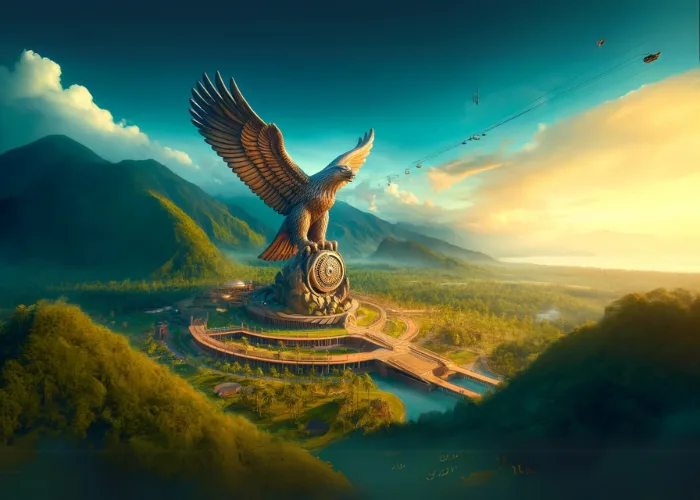Varadharaja Perumal Temple: Divine Splendors
Varadha Perumal Temple: A Divine Abode of Spiritual and Architectural Splendor
Nestled in the ancient city of Kanchipuram, Tamil Nadu, the Varadha Perumal Temple stands as a glorious testament to India's cultural heritage. Dedicated to Lord Vishnu, this majestic temple has captivated the hearts of pilgrims and tourists alike with its awe-inspiring architecture and profound spiritual traditions.
With a history dating back several centuries, the Varadha Perumal Temple gained prominence under the illustrious rule of the Cholas in the 11th century. Since then, it has been a cherished site of religious devotion and has witnessed the patronage of various dynasties, including the Vijayanagar Empire.
The architectural marvel of the Varadha Perumal Temple is a sight to behold. Adorned with towering gopurams intricately carved with gods, goddesses, and mythical creatures, the temple showcases the mastery of ancient Indian craftsmen. Inside, a 100-pillared hall displays breathtaking sculptures depicting the divine incarnations of Lord Vishnu.
Surrounded by the tranquil Anantha Saras temple tank, the Varadha Perumal Temple exudes an aura of peace and serenity. It is not just a place of worship but also an invaluable cultural and historical landmark, deeply intertwined with the rich tapestry of Tamil Nadu's heritage.
Key Takeaways:
- The Varadha Perumal Temple in Kanchipuram, Tamil Nadu, is a divine haven renowned for its architectural splendor and spiritual significance.
- With roots tracing back centuries, the temple gained prominence under the Chola dynasty and received contributions from the Vijayanagar Empire.
- The Varadha Perumal Temple boasts exquisite Dravidian architecture, characterized by detailed carvings on towering gopurams and a magnificent 100-pillared hall.
- Festivals like Brahmotsavam and Vaikunta Ekadashi bring the temple to life, offering visitors a chance to witness vibrant processions and participate in sacred rituals.
- The temple's serene surroundings, including the sacred Anantha Saras temple tank, add to its spiritual ambiance and allure.
History of Varadharaja Perumal Temple
The history of Sri Varadaraja Perumal Temple in Kanchipuram dates back to the early centuries of the common era. The temple gained prominence under the rule of the Cholas in the 11th century. Over the centuries, various dynasties, including the Vijayanagar Empire, made contributions to the temple's architecture and expansion. King Krishnadevaraya, a prominent ruler of the Vijayanagar Empire in the 16th century, added majestic structures and great wealth to the temple, leaving a lasting legacy. The temple's historical significance is also evident in ancient Tamil literature, particularly in the hymns of the Alvars, the mystic poet-saints who composed songs in praise of Lord Vishnu. The temple is featured in medieval historical records and regional chronicles, further solidifying its importance throughout history.
| Timeline | Event | Significance |
|---|---|---|
| 11th century | Under Chola rule, the temple gains prominence. | The temple establishes itself as a significant religious and cultural center. |
| 16th century | King Krishnadevaraya of the Vijayanagar Empire enhances the temple's architecture. | The temple's grandeur and wealth are elevated, leaving a lasting legacy. |
| Ancient times | The Alvars compose hymns praising Lord Vishnu in the temple. | Acknowledgment of its spiritual significance in Tamil literature. |
| Medieval period | The temple is featured in historical records and regional chronicles. | Evidence of its enduring importance throughout history. |
Architecture of Varadharaja Perumal Temple
The architectural grandeur of Sri Varadaraja Perumal Temple is a testament to the craftsmanship and artistic mastery of ancient Indian builders. The temple showcases a magnificent Dravidian style of architecture, with towering gopurams adorned with intricate carvings, depicting deities, mythical creatures, and floral motifs.
The temple also features a 100-pillared hall, an exemplary illustration of Vijayanagar architecture, showcasing sculptures of gods, goddesses, and scenes from Hindu epics.
The sanctum sanctorum, housing the main deity Lord Varadaraja, is a masterpiece of ancient temple architecture, with a vimana adorned with detailed sculptures and crowned with a golden dome. The temple's layout and design seamlessly integrate with the natural environment, harnessing natural elements such as sunlight and wind to enhance the spiritual ambiance.
Temple Architecture Highlights:
| Architectural Element | Description |
|---|---|
| Gopurams | Towering gateways adorned with intricate carvings of deities, mythical creatures, and floral motifs. |
| 100-Pillared Hall | A splendid hall showcasing sculptures of gods, goddesses, and scenes from Hindu epics, demonstrating the Vijayanagar architectural style. |
| Sanctum Sanctorum | Housing the main deity Lord Varadaraja, the sanctum sanctorum is a masterpiece of ancient temple architecture, with a vimana adorned with detailed sculptures and crowned with a golden dome. |
| Natural Integration | The temple's layout and design harmoniously blend with the natural environment, utilizing sunlight and wind to create a serene and sacred atmosphere. |
The architectural splendor of Varadharaja Perumal Temple is not only a visual delight but also an embodiment of devotion and artistic brilliance.
Festivals and Religious Practices at Varadharaja Perumal Temple
Varadharaja Perumal Temple is renowned for its vibrant festivals and rich religious practices. One of the most significant celebrations is the Brahmotsavam, held during the Tamil month of Vaikasi. This grand festival fills the air with fervor and joy, as devotees participate in processions, rituals, and cultural events. The entire town of Kanchipuram comes alive, adorned with colorful decorations, creating a captivating carnival of spiritual ecstasy.
An equally exhilarating festival at Varadharaja Perumal Temple is the Vaikunta Ekadashi, observed in December-January. Devotees eagerly await this auspicious occasion, marking the opening of the gates to Vaikunta, the heavenly abode of Lord Vishnu. The temple hosts elaborate ceremonies, including the symbolic opening of the Swarga Vaasal (the gateway to heaven), attracting countless devotees seeking divine blessings.
During these joyous festivals, the temple deities are majestically carried in grand processions, accompanied by music, dance, and joyous chants. Devotees throng to witness these enchanting spectacles, immersing themselves in the divine atmosphere.
For those seeking darshan of Lord Varadaraja, the temple offers specific timings. This systematic approach ensures a smooth flow of devotees and maximizes their opportunities to seek the blessings of the deity. Upon entering the temple, visitors are enveloped in a serene ambiance, engaging in ancient rituals, heartfelt prayers, and the humble offering of prasadam (sanctified food) to Lord Varadaraja.
FAQ
Where is Varadharaja Perumal Temple located?
Varadharaja Perumal Temple is nestled in the ancient city of Kanchipuram, Tamil Nadu.
What is the historical significance of Varadharaja Perumal Temple?
The temple dates back to the early centuries of the common era and gained prominence under the rule of the Cholas in the 11th century. It has been a place of worship and cultural importance for centuries.
Can you tell me about the architecture of Varadharaja Perumal Temple?
The temple showcases a magnificent Dravidian style of architecture with towering gopurams adorned with intricate carvings and a 100-pillared hall featuring sculptures of gods and goddesses. The sanctum sanctorum, housing the main deity Lord Varadaraja, is a masterpiece of ancient temple architecture.
What festivals are celebrated at Varadharaja Perumal Temple?
The temple celebrates various festivals throughout the year, including the grand Brahmotsavam in the Tamil month of Vaikasi and the Vaikunta Ekadashi festival in December-January. These festivals involve processions, rituals, and cultural events.
What are the timings for darshan at Varadharaja Perumal Temple?
The temple has specific timings for darshan, ensuring a smooth flow of devotees. It is best to check with the temple authorities for the most up-to-date information.
What is the significance of Varadharaja Perumal Temple?
Varadharaja Perumal Temple holds great significance as a religious, cultural, and historical landmark deeply integrated into the fabric of Tamil Nadu's history. It is a place of devotion and spiritual significance for devotees of Lord Vishnu.




